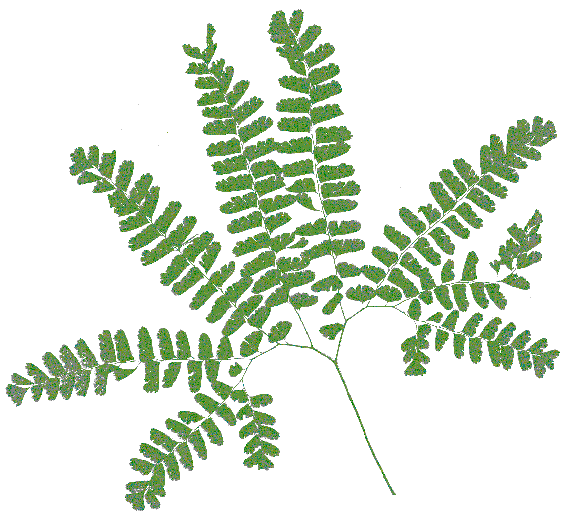 Athens Conservancy
Athens Conservancy Athens Conservancy
Athens Conservancy
Several local organizations are working cooperatively to try to curb the spread and prevalance of invasive exotic plants in Athens County, Ohio. The term "invasive exotic" refers to plants that are not native, and which are "superweeds". These plants not only spread profusely, but in the process they destroy native wildlife habitat and crowd out more desirable native plants -- and many of them make life miserable for people trying to spend time outdoors, forming impenetrable thickets and catching with thorns.
Invasive exotics have already done a great deal of damage to our native lands. Lands most impacted are generally those that were in forest but which have been cleared, either permanently or temporarily (as in clearcutting forest). Many of these plants will readily invade wild lands when large openings are created, while others, such as multiflora rose, are often already present in the understory and will quickly take advantage of openings to form a monoculture that displaces everything else.
We want to keep the wild lands of our area in as close to a natural state as possible, and combatting these invasive weeds is a key part of doing that.
Agencies involved in this program include:
Descriptions of Invasives | |
 |
Garlic mustard, Alliaria petiolariaGarlic mustard is a biennial, meaning that it grows its first year as a low rosette of leaves, then in its second year sends up a flowering spike, sets seed and dies. The seeds are small and the plant spreads mostly by seed drop. Seeds are also sometimes washed downstream or hitchhike in mud stuck to shoes, animal paws, bicycle tires or car tires. Eradication tips:Pull in early to mid-April, and then again in mid-May, and pull second-year plants first, which are starting to form a flowering spike. If it's pulled before seed pods are set, then it may be composted, or hung over branches to dry out or left on a roadway or trail surface. However, if the seed pods are already set, then the plant should be bagged for the landfill or burned. When pulling, grasp the plant as far down as possible, preferable at the top of the roots, since they have a tendency to break off just above the roots and then the roots grow a new plant. It's important to pull again in mid- to late May, because small plants often send up flowering stalks later than the larger plants. |
 |
Multiflora rose, Rosa multifloraMultiflora rose is a viciously thorny plant that persists in shade, awaiting the day when a tree falls and it can grow vigorously. It may form immense and impenetrable thickets, and many a woodland has become literally impassable to humans because of multiflora rose infestations. It can easily be distinguished from native roses because it has white flowers (natives all are pink) which are smaller, and it has many of them to a branch. It forms rose hips that are then eaten by birds and the seeds are spread in bird feces. Eradication tips:Cut the canes and pull them free, then use a mattock, grub hoe or shovel to dig out the roots. It may be difficult to get all the roots, so check for new sprouts the following year. If you find plants that have diseased branch tips, sick with a virus that turns them bright red, clip those branch tips off infected plants (but not all of them), and drop them into healthy plants. |
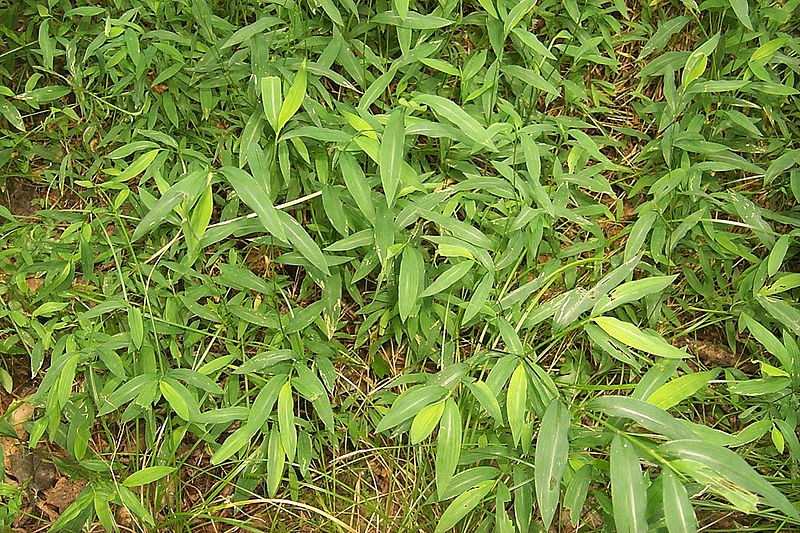 |
Asian stilt grass, Microstegium vimineumAsian stilt grass is a relative newcomer to our area, and is to be looked for along horse trails, especially. It is often spread through horse feed or horse grazing. Eradication tips:Pull, grasping the stalks as close to the ground as possible; if there is seed, then either burn the plant or bag it for the landfill. You may also use a shovel to dig up a clump, then shake the dirt out of the roots. An alternate method, and probably the best method, is to scour it to the ground with a string trimmer, and the best time to do that is in early September. |
 |
Japanese honeysuckle, Lonicera japonicaJapanese honeysuckle has spread throughout the eastern American woodlands, and is a common problem. It vines up trees but often persists in dense shade as a groundcover. It is spread by birds eating the black berries, then defecating the seeds. Eradication tips:It may be controlled by hand-pulling, but each root node next to the ground must be located and pulled. An alternative method is to carefully spray with a diluted herbicide during winter months when it is still green and other plants have died back for the year. Do this with extreme caution: only when no rain is forcast for at least 48 hours, when there is no wind, and use a wand sprayer with an adjustable tip that allows you to highly target the plants. Check the infested area first for other evergreens that may be harmed, including certain orchids and ferns, and be careful not to spray these. |
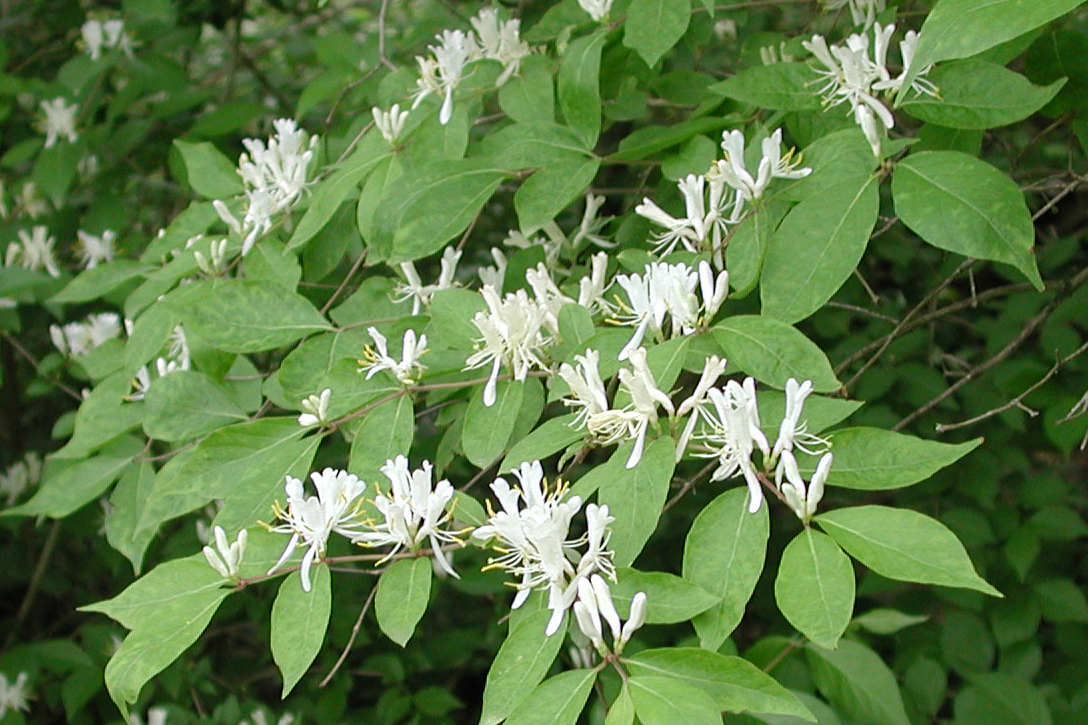 |
Amur honeysuckle, Lonicera maackiiThis honeysuckle forms large, arching shrubs that positively shade out everything else beneath them. It is spread through birds eating the red berries then defecating the seeds in new locations. Eradication tips:This shrub is often amazingly easy to pull by hand. Larger shrubs should be cut off close to the ground, and concentrated herbicide applied directly to the cut surface. |
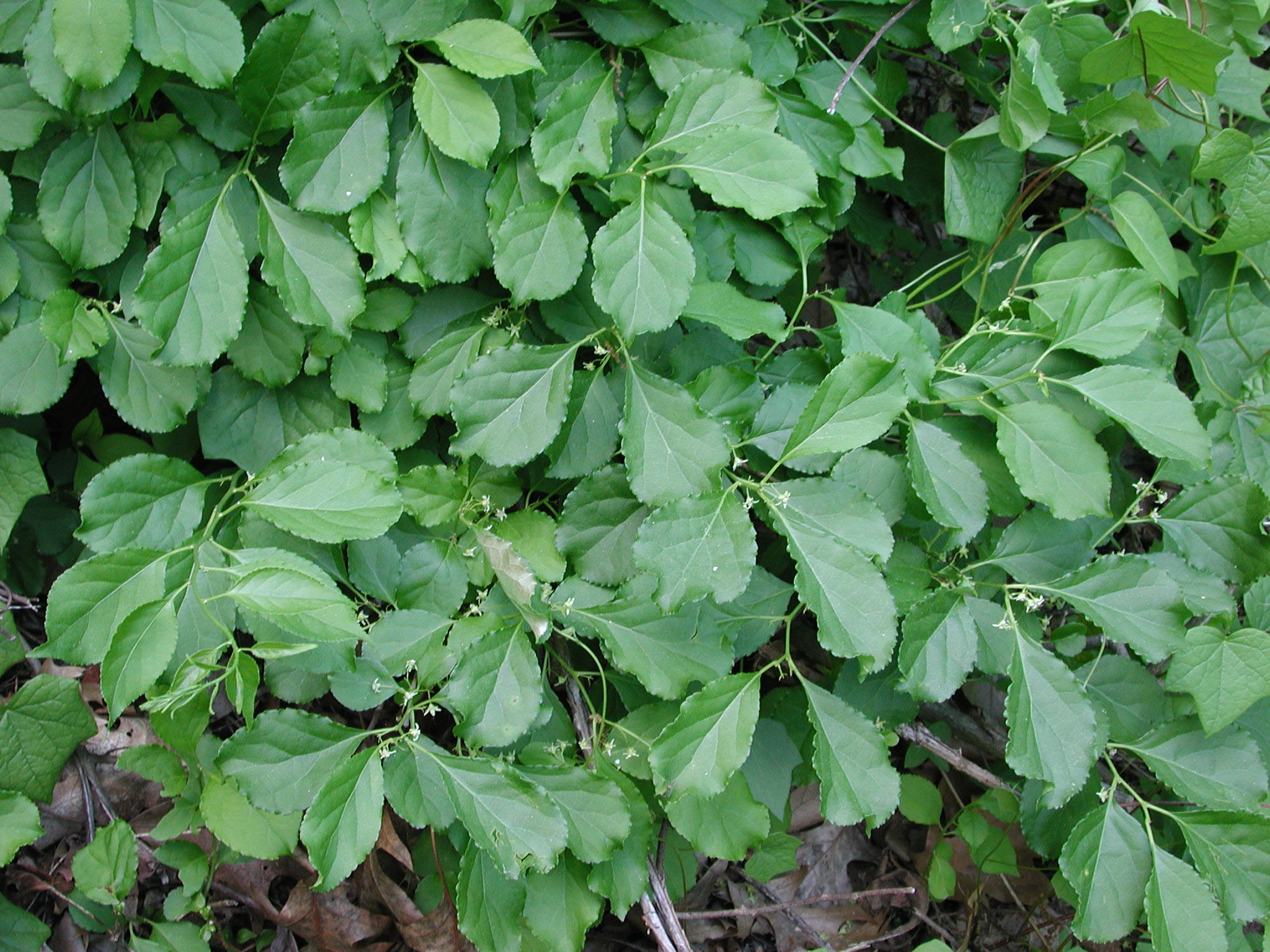 |
Asian bittersweet, Celastrus orbiculatusIf you see any bittersweet vine in our area, it is almost certainly Asian bittersweet, also called Oriental bittersweet. This vine forms dense thickets and may kill even mature trees by shading if it can get a twining purchase to reach the top. Birds eat the berries and defecate out the seeds to spread it. Eradication tips:Hand-pulling is the best method of dealing with this plant, but it's usually necessary to pull bit by bit, walking down the runners as you pull them (and return the next year to check!). Of course, cut all the ascending vines. Often, there may be many small vines growing up from a large rootstock. |
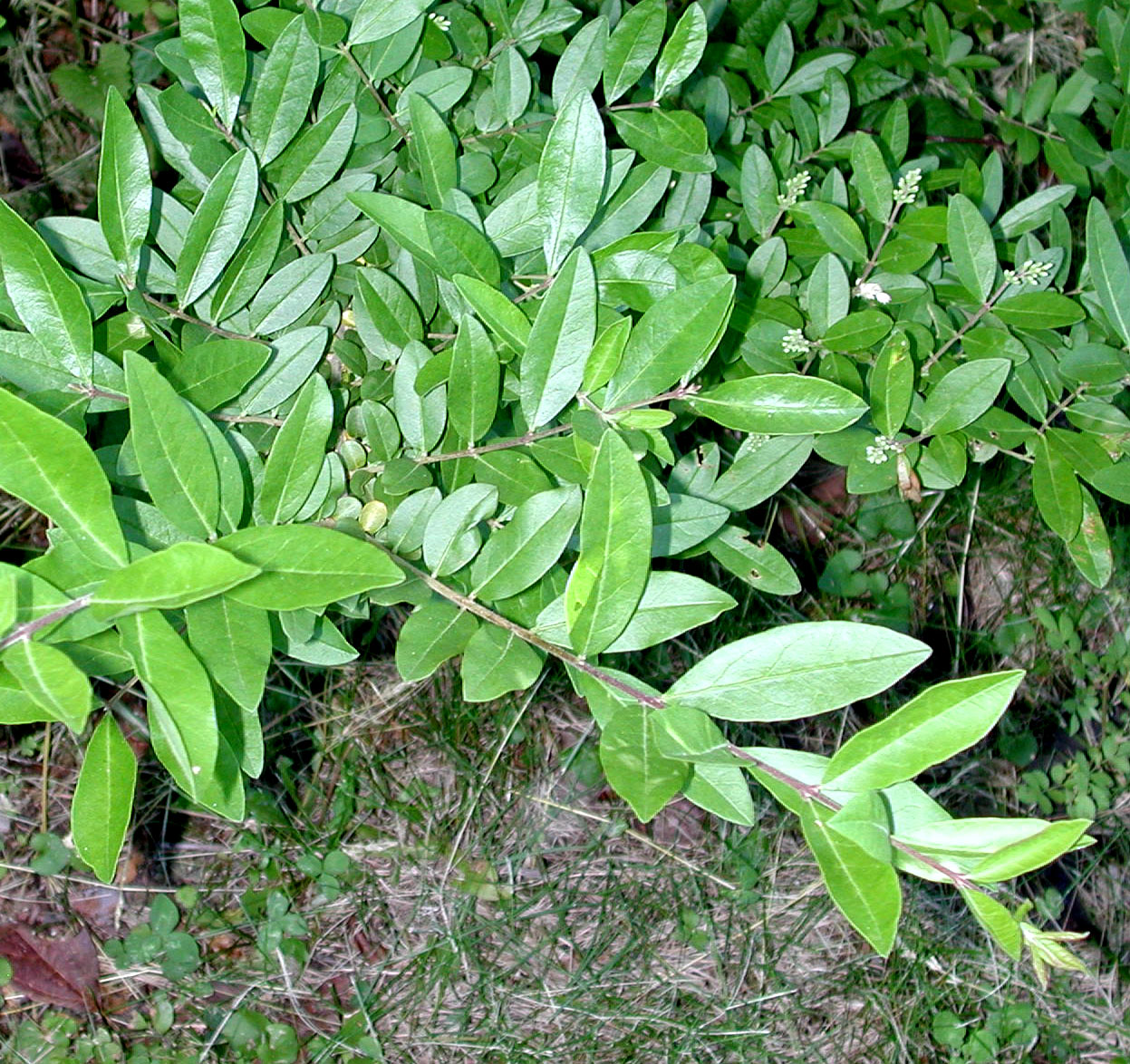 |
European privet, Ligustrum vulgareThis woody shrub will form large thickets, spreading by sprouts from the roots. Small branchlets may mimic thorns, making the thickets difficult to penetrate. Branches will also root to form new shrubs. Birds eat the black berries and distribute the seeds in their feces. Eradication tips:Smaller plants may often be easily hand-pulled, and pulling one often leads to the next via connected roots. Larger plants may be cut off close to the ground, and concentrated herbicide applied to the cut surface. |
.jpg) |
Burning bush, Euonymus alatusThis woody shrub will form dense thickets of stems, growing parallel and close together. Birds eat the red berries and spread the seeds through their feces. Eradication tips:If the plants aren't too large, they can generally be hand-pulled. However, hand-pulling may be difficult, and it may be useful to grub them up with a mattock. If they can't be pulled or grubbed, then cut the stems close to the ground and apply concentrated herbicide to the cut surface. |
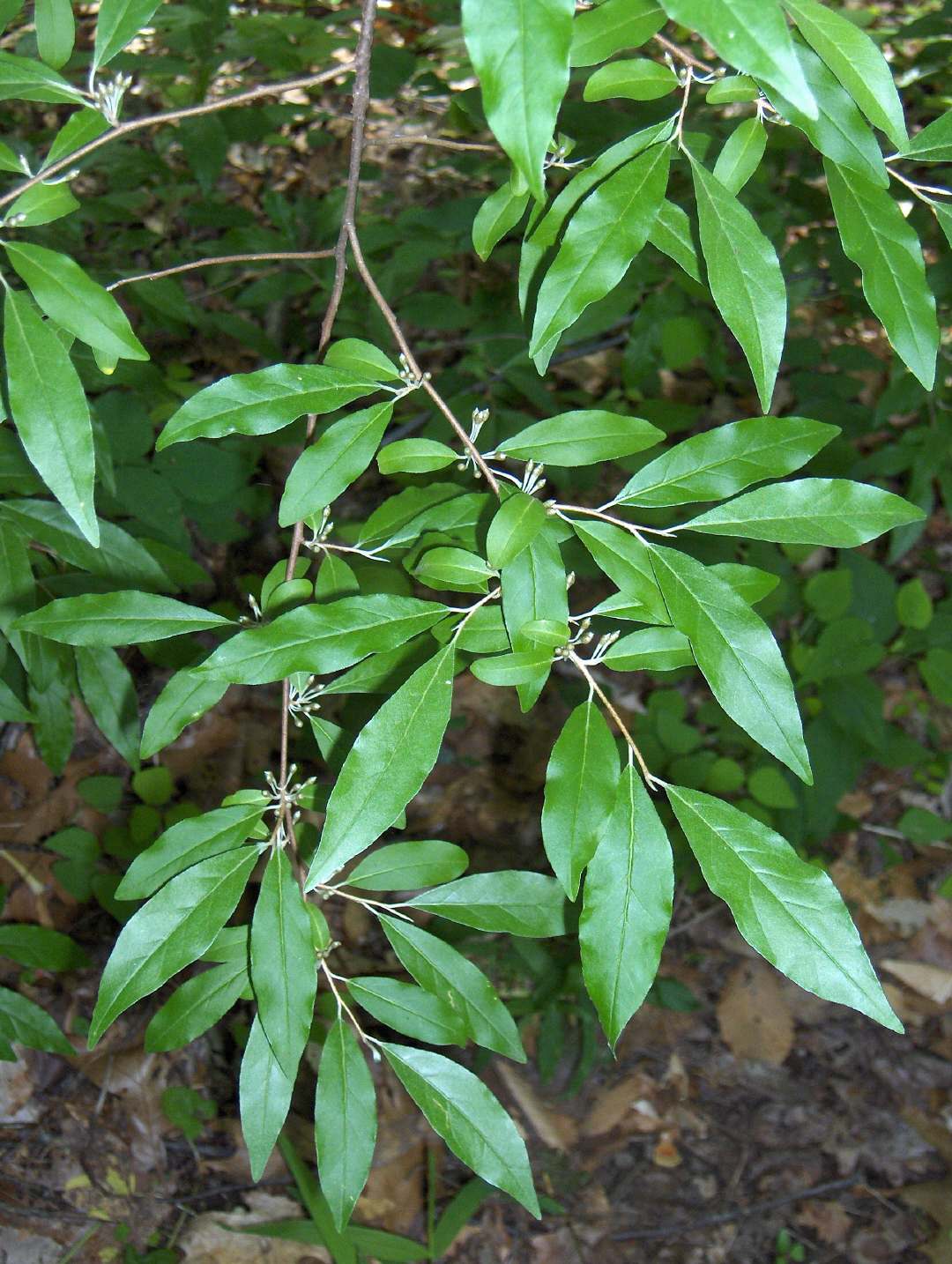 |
Autumn olive, Eleagnus umbellataAutumn olive is easy to recognize from the silvery undersides of the leaves and the grayish-green upper surfaces. Large plants growing together and forming thorns may create an almost impenetrable thicket. The birds eat the dark berries and spread the species by seed through their feces. Eradication tips:Smaller plants should be pulled. Larger plants should be killed by cutting the woody stems close to the ground and applying concentrated herbicide to the cut surfaces. |
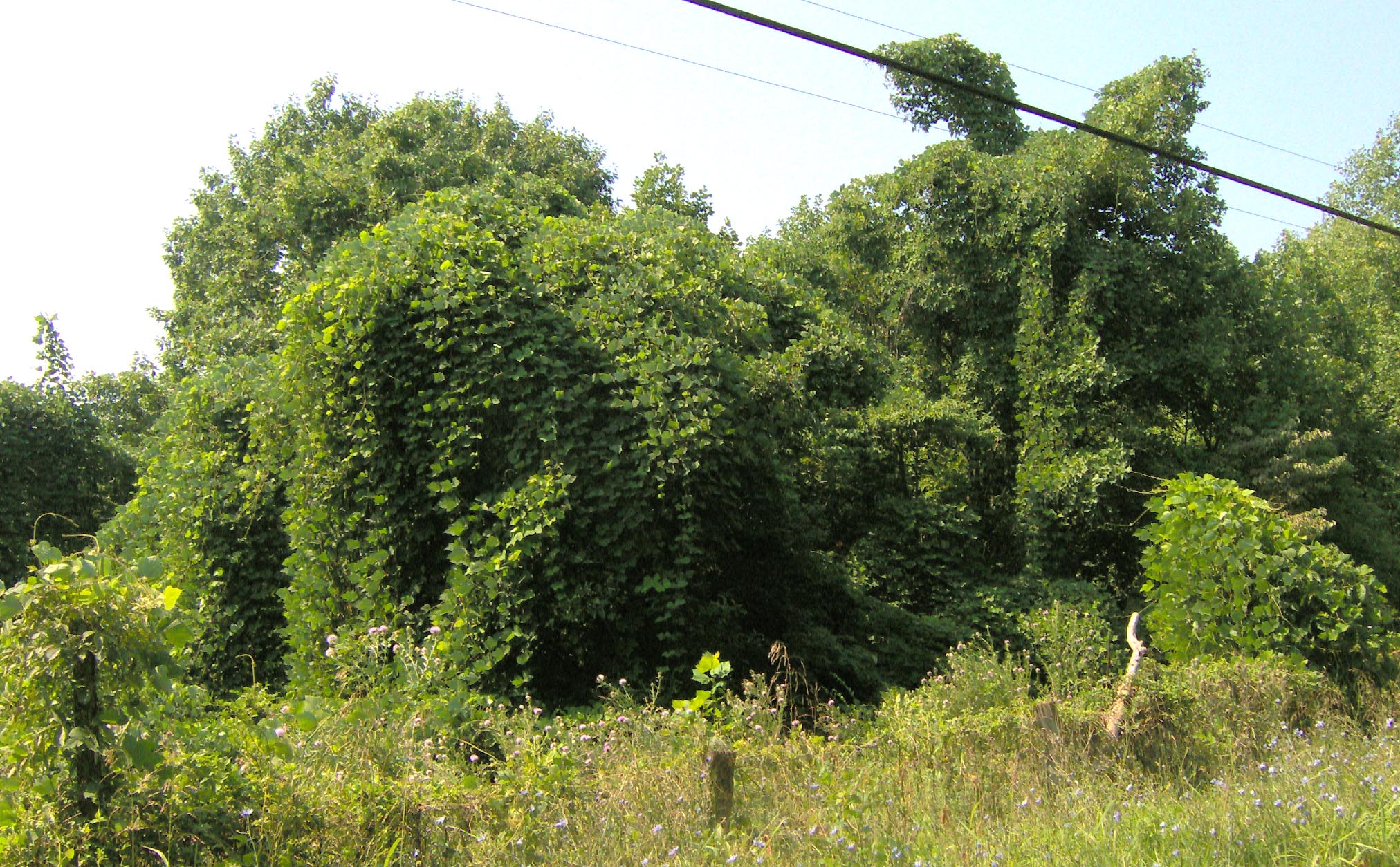 |
Kudzu, Pueraria lobataKudzu is widely known as the terror of the American South, a vine that eats trees and even whole woodlands. Under optimal conditions, this vine grows so fast that you can watch it growing -- up to an inch per hour! While we have several patches in our area, it does not as yet appear to be re-seeding itself. Eradication tips:Very difficult to eradicate without using herbicides. |
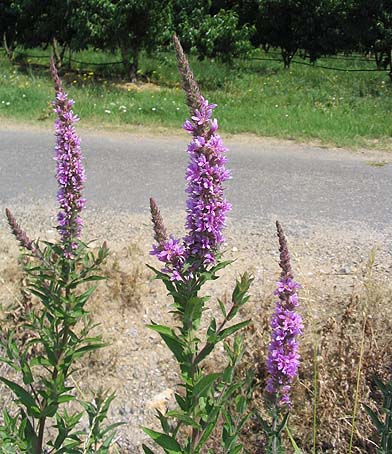 |
Purple loosestrife, Lythrum salicariaPurple loosestrife is a beautiful plant that often causes people to exclaim in admiration at its purple spires of flowers -- but it takes over huge areas in open, sunny stream bottoms. Once established, it is very difficult to eradicate. Eradication tips:Pull this plant when the ground is moist. Even then, it's often very difficult to pull. Be sure to grasp the stem low down when pulling. Check back from year to year to find sprouts from missed roots. This plant often grows in areas that are too wet for safe use of herbicides. |
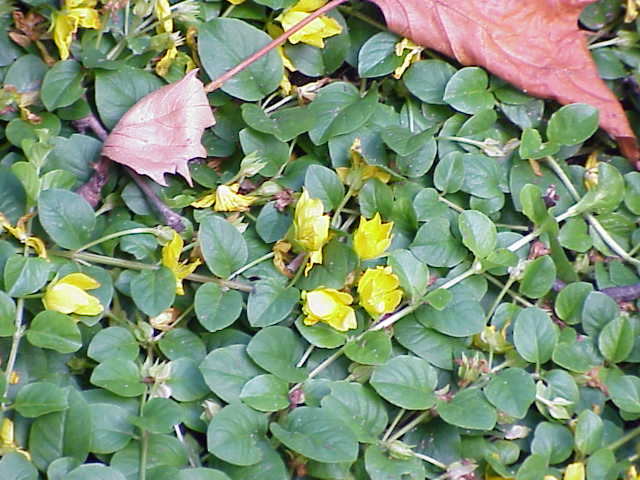 |
Moneywort, Lysimachia nummulariaMoneywort is an attractive ground-hugging herbaceous vine that grows in sunny, wet locations, with yellow flowers. It has become widespread but it is uncertain how much damage it's doing, but it's certainly displacing native plants. It spreads rapidly through its vining habit. Eradication tips:Hand-pulling is easy but tedious. Every bit of vine stem must be removed. However, moneywort's normal habitat is a dangerous place for herbicide use. |
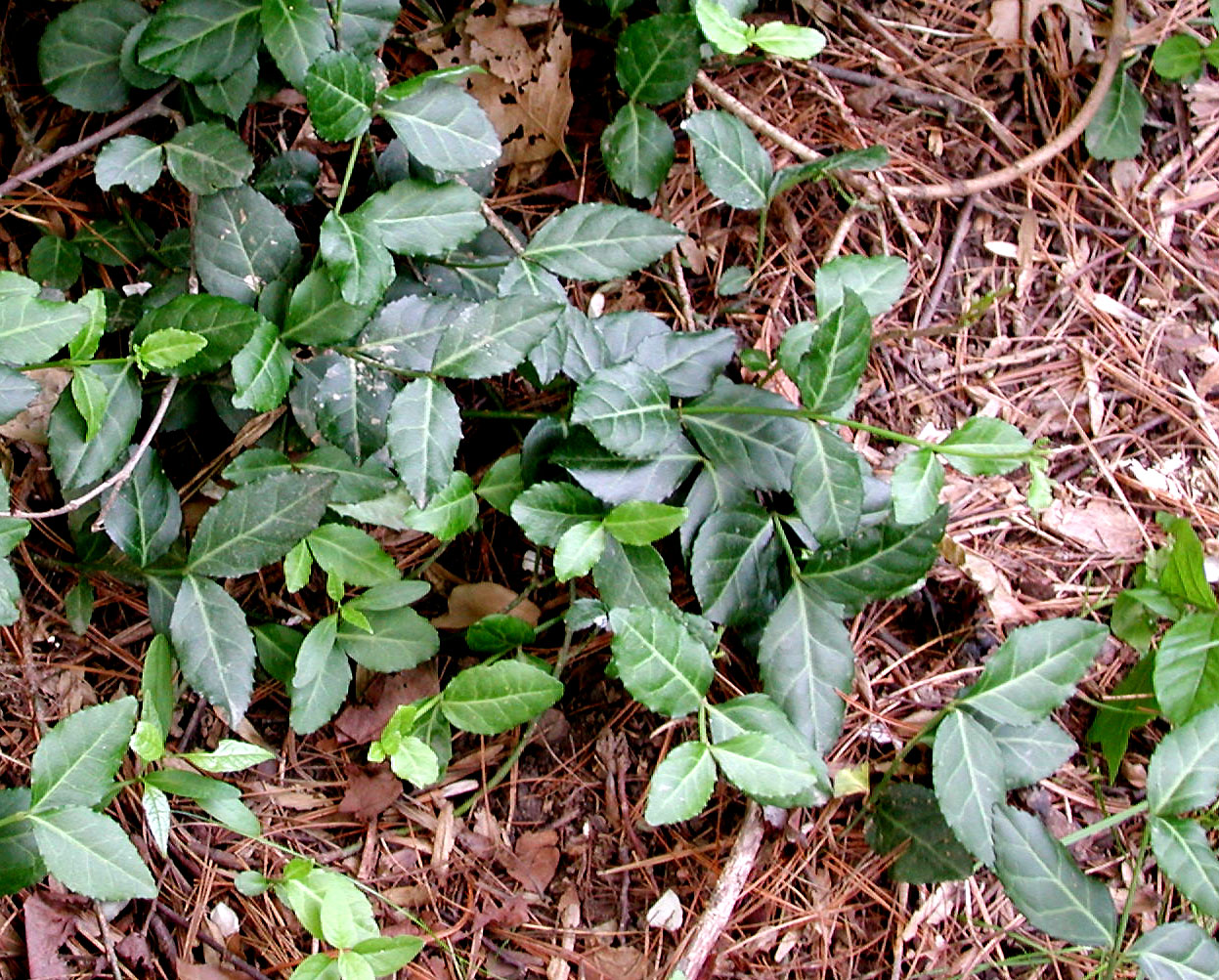 |
Wintercreeper, Euonymus fortuneiWintercreeper is an attractive ground cover, but can crowd out more desirable herbaceous plants. It forms a dense ground cover and will climb trees, clinging with aerial roots like poison ivy. Eradication tips:Hand-pulling is tedious but effective, and more easily done than with Japanese honeysuckle. However, you will find a tangle of overlapping vines, and it takes a lot of determined pulling. Like Japanese honeysuckle, it can also be attached by winter spraying of herbicides. |
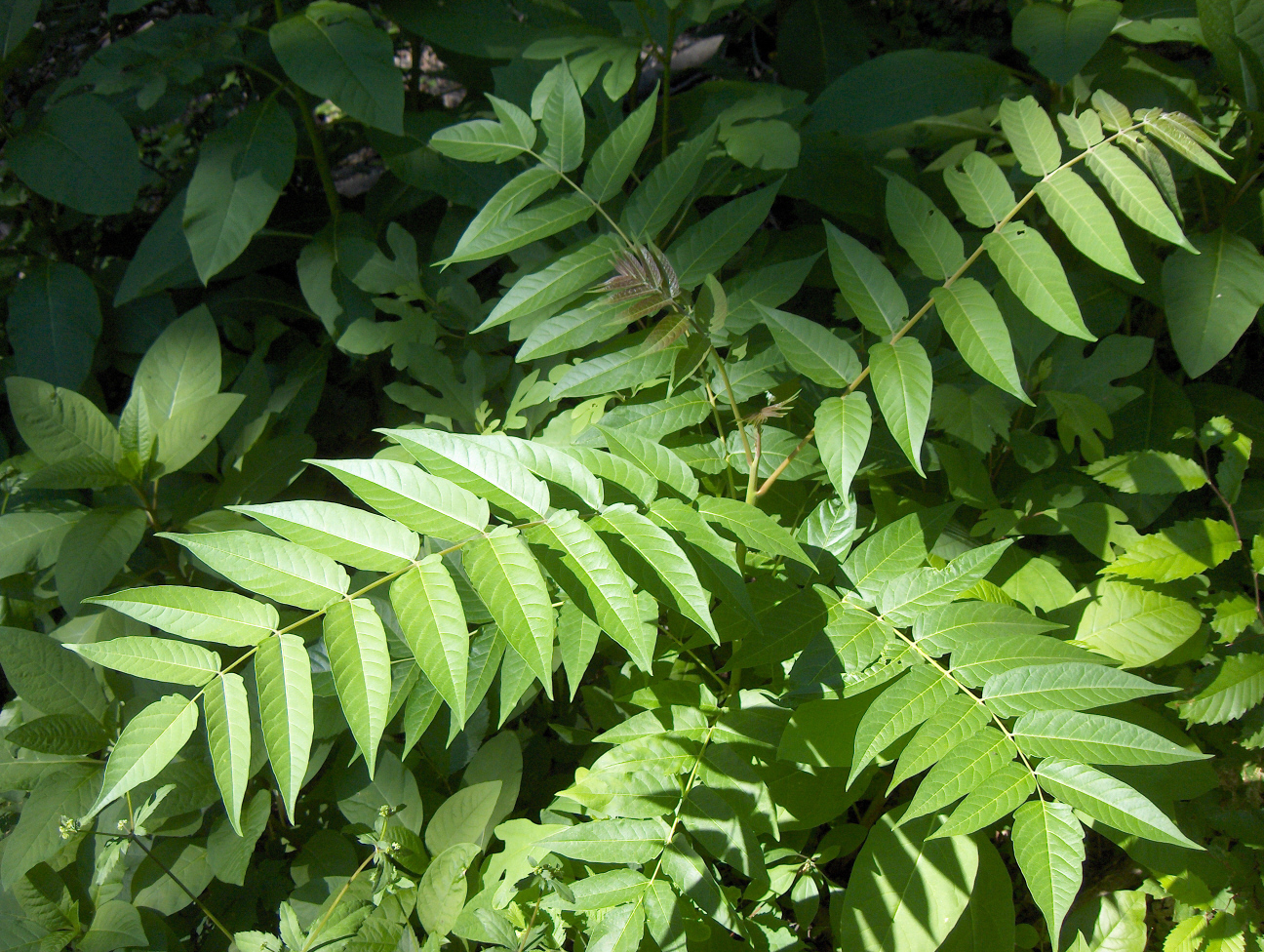 |
Tree-of-Heaven, Ailanthus altissimaWhy this is called tree-of-heaven is a bit of a mystery; stink-tree is a much better name. This is a weak-wooded, fast-growing, weedy, stinking tree that prolifically sprouts from roots and from seed. Its leaves are long compound leaves somewhat similar to ash or walnut but are readily distinguished by their odor when rubbed. Even where there is no large, this species often persists in the understory as small saplings, often connected by a root system. Eradication tips:Hand-pulling can be effective, but it's necessary to grab the stem as far down as possible, because they will otherwise break off just above ground level. They will commonly re-sprout for several years, however. The stems may also be cut just above ground surface and concentrated herbicide applied to the cut surface. |
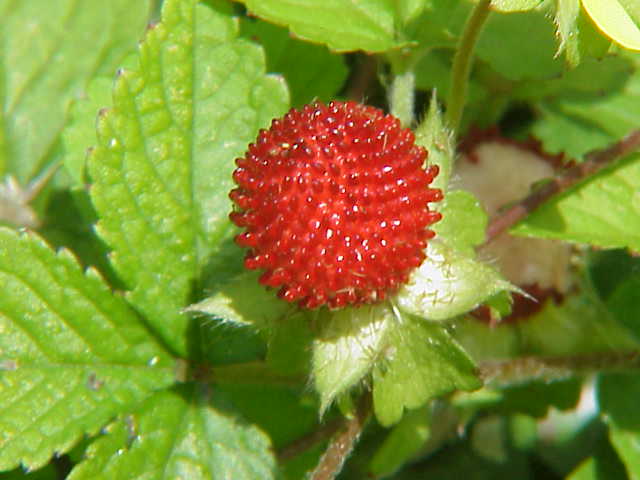 |
Mock strawberry, Potentilla indicaThis species, which is also called Indian strawberry, looks much like wild strawberry but may be readily distinguished in spring by its yellow flowers (real strawberries have white flowers). The fruit, also, is insipid, with the seeds above the surface rather than imbedded in it as in real strawberries. It's often pervasive through the woods. It's usually not a major problem in woodlands, but often becomes a significant problem in rockhouses (shallow caves) and other marginal habitats where it may crowd out more desirable native species. Birds may spread the seeds by eating the fruit and defecating the seeds. Eradication tips:Pull, pull, pull. It's very easy to pull, and each plant makes a discrete ground. Plants spread by ground-surface stolons, so while pulling, these often lead to other plants. As long as these don't have berries on them, they can just be put some place where they'll dry out. |
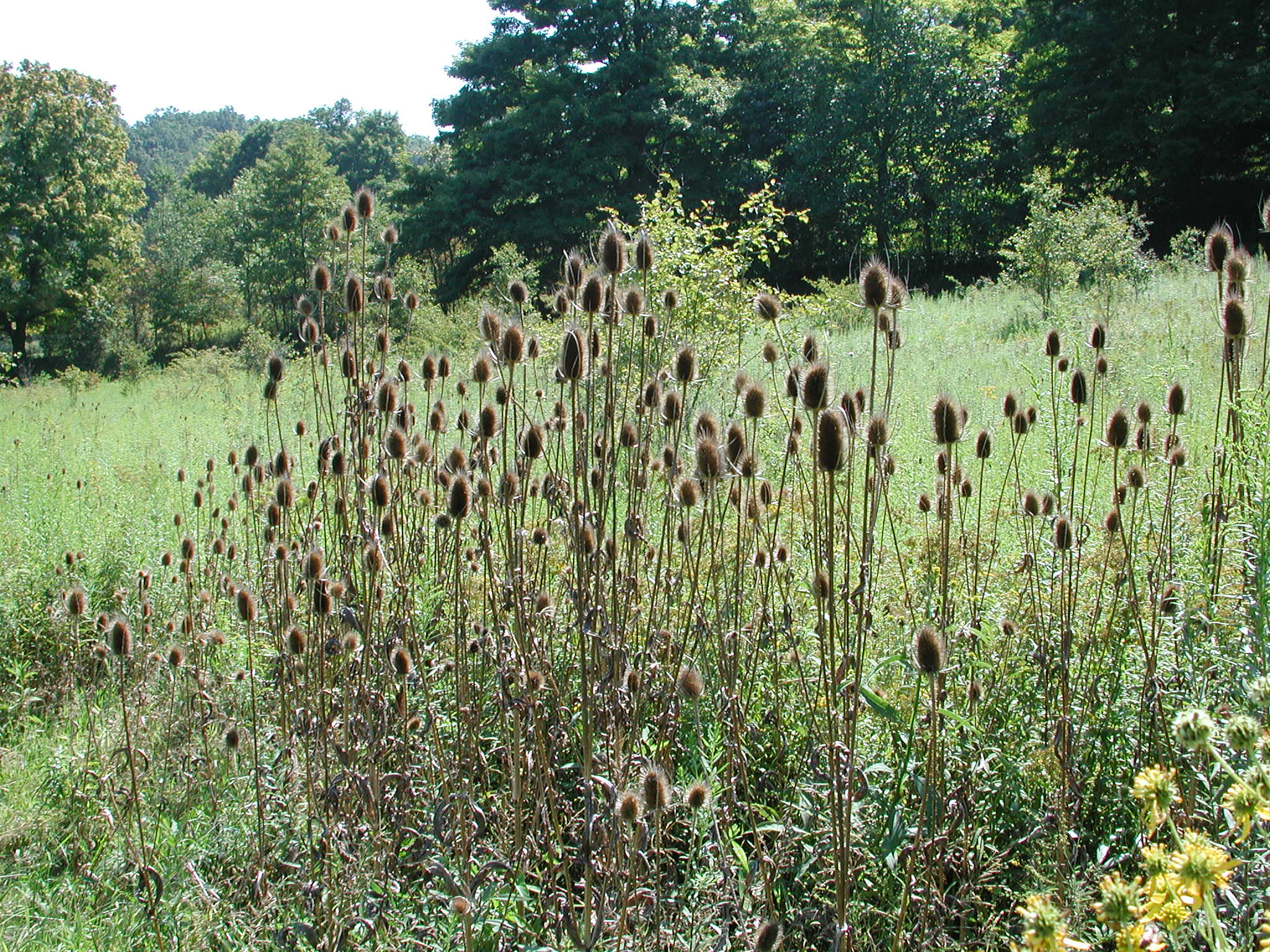 |
Teasel, Dipsacus fullonum and Dipsacus laciniatusThese are very distinctive plants, although many people confuse them with thistles. The entire plant is spiny. The flowerheads are very distinctive, looking a little like pine cones or pineapples, with thousands of tiny little openings, each of which has a tiny flower. The flowers start blooming in a ring around the middle of the flowerhead, and then the blooms gradually spread towards the ends. D. fullonum blooms a lilac color, while D. laciniatus blooms white. Leaves of these plants are opposite (paired) and clasp each other at the stem, more strongly in D. fullonum, which has entire leaves, while D. laciniatus has lobed leaves -- sparsely-lobed towards the top, densely-lobed towards the bottom. Both of these plants, which are biennials, make very exclusionary stands.
It's essential to get rid of the flowers before they set seed to interrupt the seeding cycle. When the plants are in flower, it's probably best to simply clip them off at the base and dispose of them. |
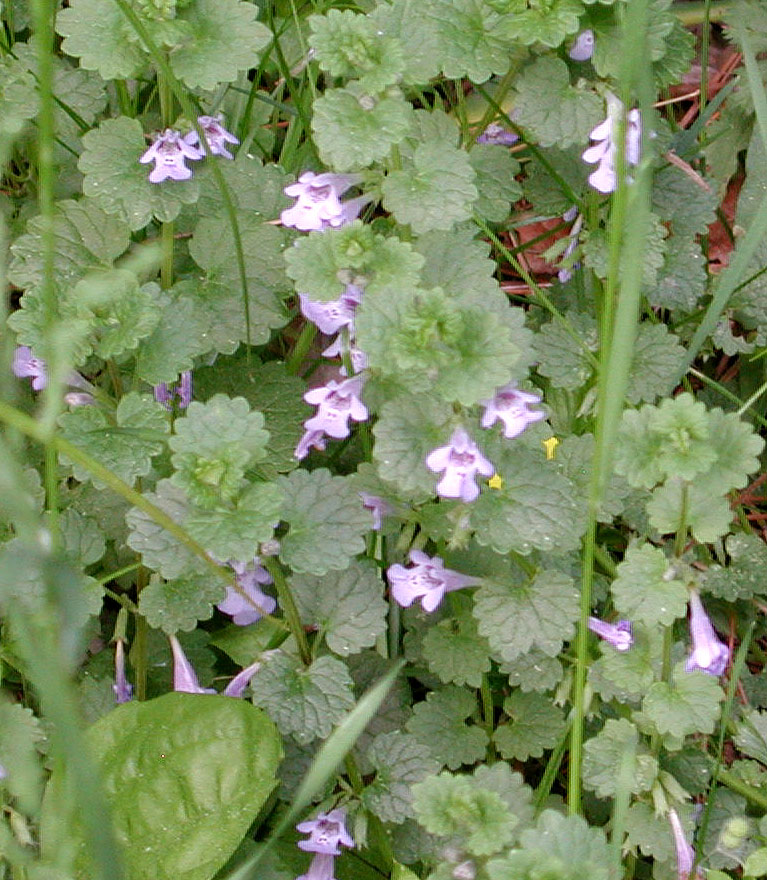 |
Ground ivy, Glechoma hederaceaThis mint relative makes a dense cover, and can grow up and over a lot of other things, like other herbaceous plants. It can make a dense tangle that's hard to deal with. |
 |
Japanese knotweed ("Himalayan fleece vine"), Polygonum cuspidatumThis plant forms dense "cane-breaks" in which nothing else can grow due to the dense crowding of the stems. It does not spread readily by seed, but once established, its spread is virtually unstoppable from year to year. It has arching, jointed stems reminiscent of bamboo, and sprays of white flowers at the cane tips. Eradication tips:Control of this plant by hand-pulling is virtually impossible. Hand-control can only be achieved by deep-digging the entire plot and pulling out all the roots. This is one of the few plants for which we recommend herbicide spraying. |
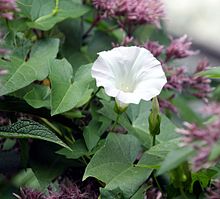 |
Hedge bindweed, Calystegia sepiumThis is a very annoying plant that pops up in field and hedge situations. It's in the morning glory family, with an attractive flower, but often festoons shrubs with its vines, shading out the shrub. Eradication tips:In a home situation, simply pull weekly. You wille eventually wear out the plant. |
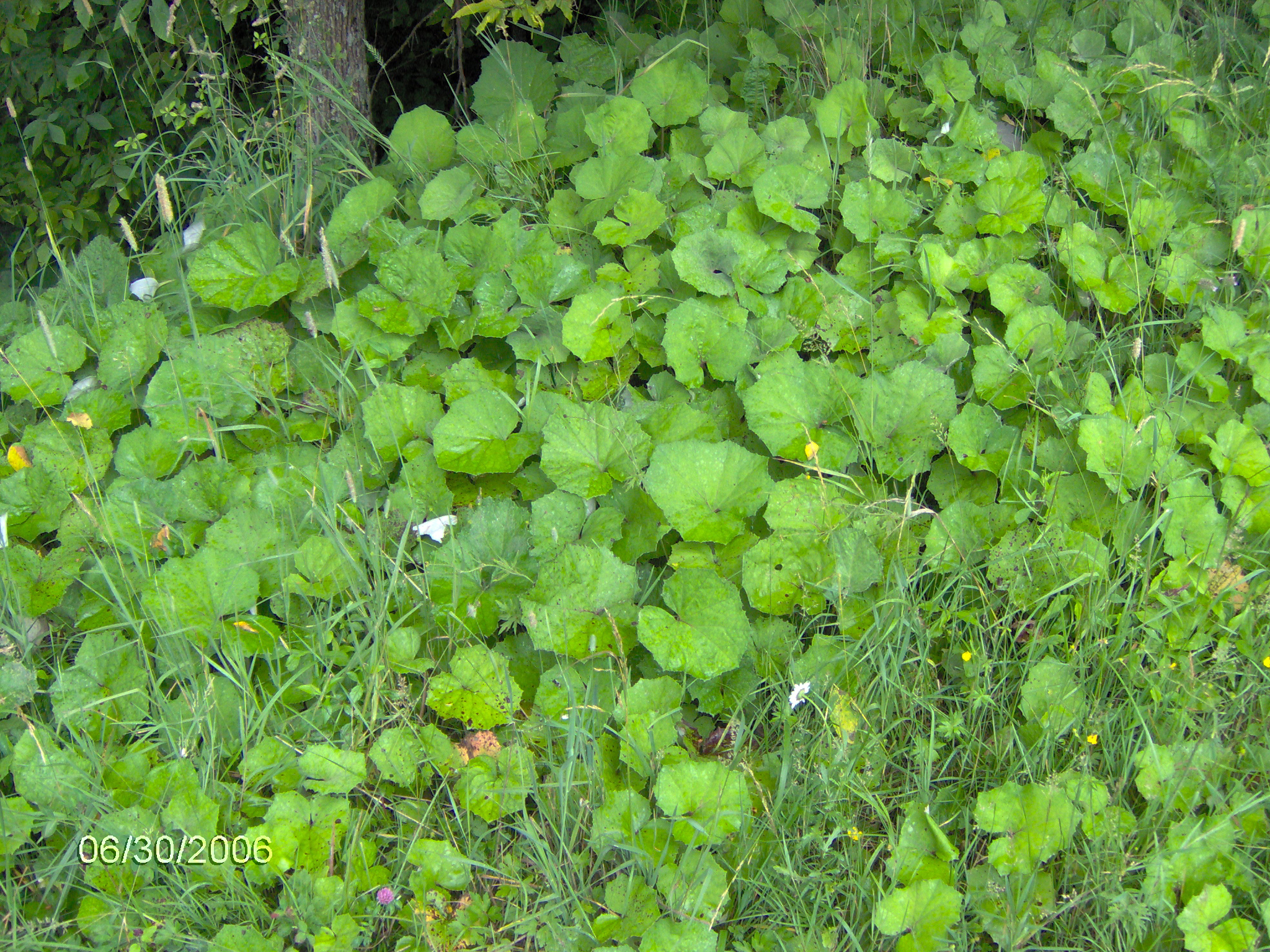 |
Coltsfoot, Tussilago farfaraColtsfoot is interesting, because it does not seem to be a problem. Like oxeye daisy and Queen-Anne's-lace, it seems to have integrated well into our ecologies, mostly inhabiting places inhospitable to other plants. It has very early dandelion-like flowers that come up before the leaves, then the large, distinctive leaves emerge. It has long-running rhziomes under the soil. |